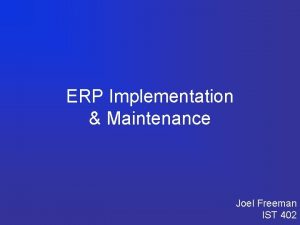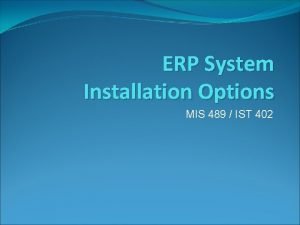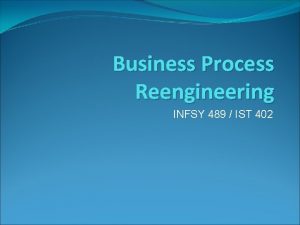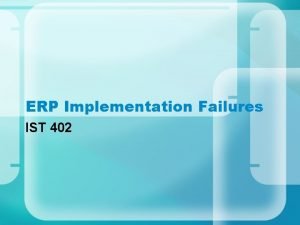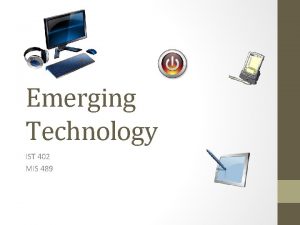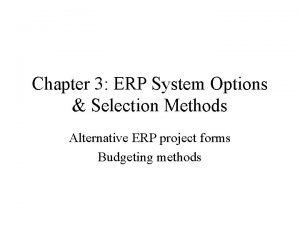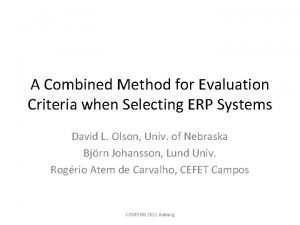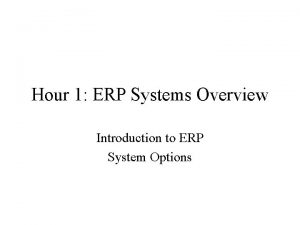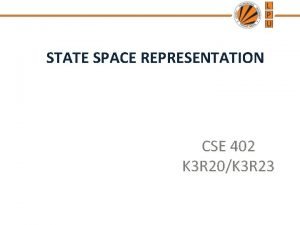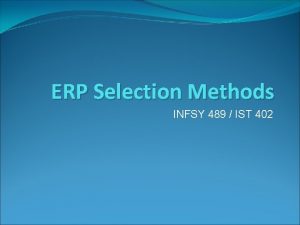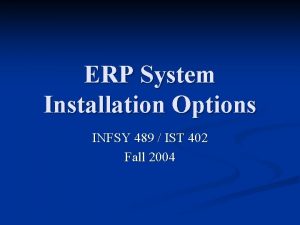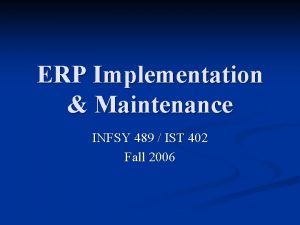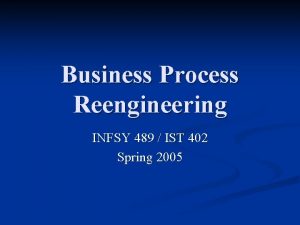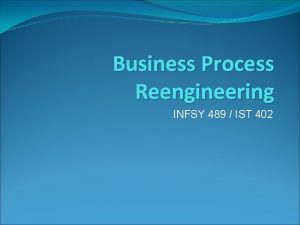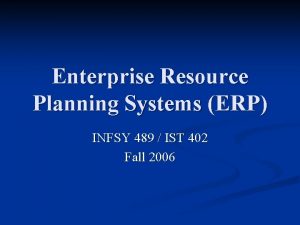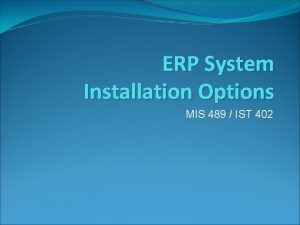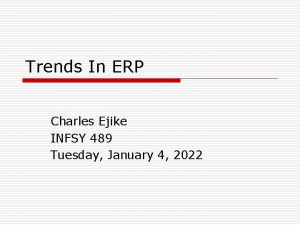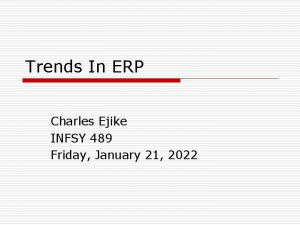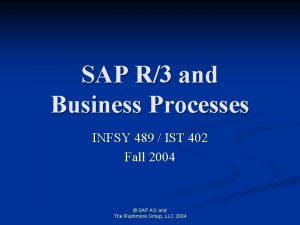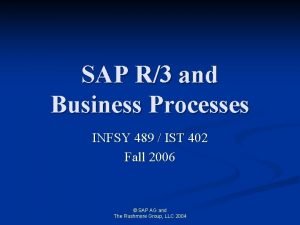ERP Selection Methods INFSY 489 IST 402 ERP



















- Slides: 19

ERP Selection Methods INFSY 489 / IST 402

ERP Selection �Cost range of ERP system is enormous �Range anywhere from $5 million to $100 million �Training employees may cost as much as 20% of ERP system’s cost �Project begins with project proposal

ERP Selection �Analytic methods support the decision process �Provide decision makers with expected outcomes �Provide a basis for communication on the reasons for a selection

How to Build an ERP Adopt only a few ERP modules from a vendor Rent an ERP product from an application service provider Adopt a vendor product completely Customize a vendor product Develop an ERP in-house

Best-of-Breed Approach �Modules considered to be competitively strong selected from multiple vendors �Custom interfaces developed to allow exchange of data

Measurement of Project Impact �Information Systems projects are often difficult to justify solely based on concrete monetary benefits �Cost-Benefit Analysis includes �Tangible Factors �Intangible Factors �Lead to competitive advantage

Measurement of Project Impact �Intangible Factors: �Increased market share �Improved customer service �Better corporate image �Improved employee satisfaction �Supply-chain integration �Ability to support e-business operations

Measurement of Project Impact �Large IT projects often change organizational power �Change the communication structure �Experienced employees may feel threatened by new system �Change work roles making some workers feel less productive

Information Technology Selection �Hinton and Kaye surveyed 50 members of a professional organization to identify how IT projects were selected �Treated IT projects as: �Capital investment using cost-benefit analysis to establish profitability �Revenue-related project expected to benefit organizational goals

Information Technology Selection �Since most organizations treat IT projects as capital investment �Have to have measurable profit benefits �Most commonly cited justification for IT projects: �Reduction in expenses, i. e. Payroll �Accomplishing a strategic objective

Information Technology Selection �IT projects involve multiple risks �Abilities of project manager �Experience with this type of application �Experience with programming environment �Experience with language or system used

Information Technology Selection �Familiarity with modern programming practices �Availability of critical equipment, software, programming language �Completeness of project team �Personnel turnover �Project team size �Relative control of project manager over project team

IT Project Approval

Evaluation Techniques �Cost-Benefit Analysis �Accurate measurement of the benefits and costs in monetary terms of project �Uses the ratio benefits/costs

Evaluation Techniques �Net Present Value �Uses present value of the cash flows expected from a proposal �If the present value of the net cash flow expected from a proposed investment, at the selected rate, equals or exceeds the amount of the investment, the proposal is desirable

Evaluation Techniques �Payback �Identify cumulative net cash flow and identify how long it will be before it turns positive

Evaluation Techniques �Value Analysis �Used when projects’ benefits are heavily intangible �Separate the benefits measured in intangible terms from costs �Present decision maker with the intangible comparisons in performance �Are the improvements provided by the new system worth the price?

Evaluation Techniques �Multiple Objectives �Profit �Minimize Risk �Develop markets �Capital replenishment �Labor policies �These items pose conflicts for decision makers in today’s businesses

Evaluation Techniques �SMART (Simple Multiattribute Rating Technique) �Considers benefits of a system on a variety of scales without converting them to a common scale like dollars �Provides a means for decision makers to quantify their preferences �Scores and Weights are used to compute a Value Score on each project
 Dr ocker
Dr ocker Ist 402
Ist 402 Ist 402
Ist 402 Ist 402
Ist 402 Ist 402
Ist 402 Ist 402
Ist 402 Technological determinism
Technological determinism Ist 402
Ist 402 Erp selection methods and criteria
Erp selection methods and criteria Software evaluation criteria
Software evaluation criteria Introduction to erp systems
Introduction to erp systems Heute mittwoch guten morgen mittwoch winter
Heute mittwoch guten morgen mittwoch winter Winter kommt winter kommt flocken fallen nieder
Winter kommt winter kommt flocken fallen nieder Es ist herbst bunte blätter fliegen
Es ist herbst bunte blätter fliegen Es ist herbst es ist herbst bunter blätter fliegen
Es ist herbst es ist herbst bunter blätter fliegen Zu glauben ist schwer. nichts zu glauben ist unmöglich
Zu glauben ist schwer. nichts zu glauben ist unmöglich Cse 402
Cse 402 Stitch type 402
Stitch type 402 Sas 70 isae 3402
Sas 70 isae 3402 8884026916
8884026916

